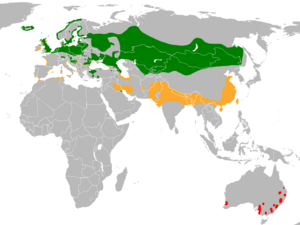Greylag goose facts for kids
Quick facts for kids Greylag goose |
|
|---|---|
 |
|
| In St James's Park, London, England | |
| Conservation status | |
| Scientific classification | |
| Genus: |
Anser
|
| Species: |
anser
|
| Subspecies | |
|
|
 |
|
| Green: breeding, orange: non-breeding, red: introduced | |
| Synonyms | |
|
Anas anser Linnaeus, 1758 |
|
The greylag goose (Anser anser) is a big grey goose that belongs to the waterfowl family called Anatidae. It is actually the largest type of goose! You can find these birds in many places around the world.
Greylag geese that live in northern Europe and Asia fly south for the winter. They go to warmer places to escape the cold. This amazing journey is called migration.
This goose is special because it is the ancestor of the domestic goose that many people keep on farms today. People have been raising greylag geese for a very long time, at least since 1360 BC! The name Anser comes from the Latin word for "goose."
Contents
Life Cycle and Habits
Greylag geese travel to their breeding grounds in the spring. These special places are usually moorlands, marshes, areas around lakes, and islands near the coast.
Nesting and Raising Young
Greylag geese usually find a partner for life. They build their nests on the ground, hidden among plants. A female goose will lay about three to five eggs.
The mother goose sits on the eggs to keep them warm until they hatch. Both parents work together to protect their young and raise them. The baby geese are called goslings.
Family Life and Migration
The goose family stays together as a group. When autumn arrives, they all fly south as part of a larger flock. The next year, the young geese will separate from their parents.
During the winter, greylag geese live in places with water. These can be estuaries (where rivers meet the sea), marshes, or fields that are flooded. They eat grass and crops from farms.
Some groups of greylag geese, like those in southern England or in cities, do not migrate. They stay in the same area all year round.
Images for kids
-
Three eastern greylag geese (A. a. rubrirostris) at Keoladeo National Park in Rajasthan, India
-
A crossbreed between a wild greylag goose and a domesticated swan goose (A. cygnoides domesticus), as evidenced by its thick neck and bulky head, both of which display vestigial patterning like certain domestic breeds
-
Ancient Egyptian stele showing Amun-Ra as goose, man, and ram. 25th dynasty, c. 700 BC.
-
Juno's sacred geese warn the Romans while the Gauls approach the Capitol in 390 BC. Lithograph after Henri-Paul Motte (1883)
-
Wood engraving "The Tame Goose, Anas anser" by Thomas Bewick, A History of British Birds, 1804
See also
 In Spanish: Ánsar común para niños
In Spanish: Ánsar común para niños





















